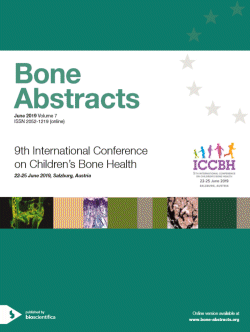Highlights in basic bone research
Highlights in clinical bone research
Biomechanics of fetal movements
Mechanical loading and bone development – insights from epidemiological studies
Nutritional rickets – a socioeconomic problem
Effect of vitamin D on body composition
Vitamin D in pregnancy and offspring immunology
Hawrylowicz Catherine , Hornsby Eve , Cheadle Charlotte , Pfeffer Paul , Laranjo Nancy , Cruikshank William , Tuzova Marina , Litonjua Augusto A , Weiss Scott T , Carey Vincent J , O'Connor George
Osteoclast disorders
Sobacchi Cristina , Palagano Eleonora , Menale Ciro , Villa Anna
ba0007is10 | (1) | ICCBH2019
Endoplasmic reticulum stress in osteoblasts
Besio Roberta , Tonelli Francesca , Garibaldi Nadia , Leoni Laura , Cotti Silvia , Forlino Antonella
ba0007is11 | (1) | ICCBH2019
Clock genes and bone and mineral regulation
ba0007is12 | (1) | ICCBH2019
Orthopaedic management of osteogenesis imperfecta in the bisphosphonate era
ba0007is13 | (1) | ICCBH2019
Craniosynostoses in rare skeletal disorders
ba0007is14 | (1) | ICCBH2019
Orthopedic needs in X-linked hypophosphatemic rickets
Ganger Rudolf Radler C , Ganger Rudolf
ba0007is16 | (1) | ICCBH2019
Current care and new therapeutic approaches to achondroplasia
ba0007is17 | (1) | ICCBH2019
TGF-beta inhibition in osteogenesis imperfecta
ba0007is18 | (1) | ICCBH2019




